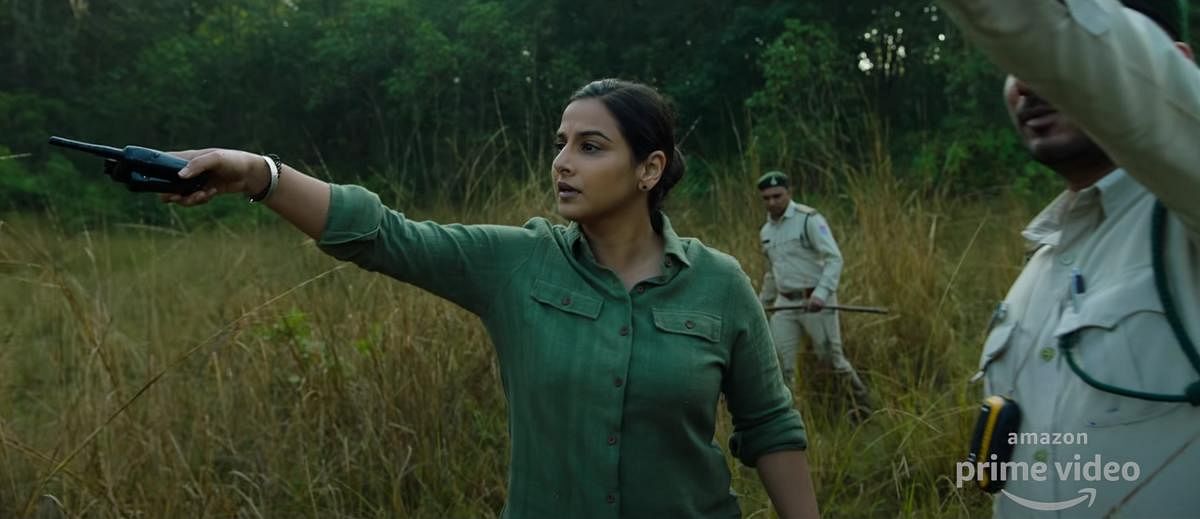
Indian cinema derives from a general inclination to purvey so-called truths, which translate as truisms or familiar sentiments that may not be relevant to the existing situation.
Young people agreeing to wed people other than those they have set their heart on (in Hum Aapke Hai Kaun) are not different from Mrinal Sen’s poor (Calcutta ’71) who bear their misery stoically when the rain is pouring in. Taking ameliorating steps would detract from their given status as dutiful children or victims.
Real situations are rarely the way Indian cinema portrays them. The latest film to do this is Amit Masurkar’s Sherni, dealing with a supposed maneater that politicians want to put down.
The protagonist is an upright forest official played by Vidya Balan, and her aim is to save a tiger from certain death at the hands of a hunter. To add gender concerns to environmental ones, Vidya Vincent is in a bad marriage and being exploited by her husband.
The choice of the tiger as subject is shrewdly calculated, as the animal draws tourist crowds most unfailingly. Some years ago, I was in Ranthambore in Rajasthan, where tiger sightings are common. The place is so famous that singer Katy Perry and Russel Brand (since divorced) chose it for their wedding and I learnt that a wild tiger had graced the occasion.
Rentals are sky-high at the resorts around Ranthambore and a luxury tent, I hear, could cost over Rs 25,000 a night. Tiger sighting is not rare but one may have to stay several nights if one’s heart is set on it. There was a scheme afoot then (since carried out, I believe) to shift a tiger from Ranthambore to Sariska, where there were no tigers. The reason was that a political bigwig owned a resort in Sariska and the room rentals would soar if tiger sighting was offered as an attraction.
People will pay through their nose for a story like this one: “Sir, the tiger was standing at this very spot with her cub. Those visitors were lucky that day.” Elephants, gaur, deer, or the nilgai don’t get the same ovation and farmers often treat them as vermin.
In Sherni, one of several tigers in the vicinity kills a cow. A little later, it kills a villager, and a hunter arrives to shoot the tiger. Tourists are never mentioned and we are led to believe that poor farmers retain their land, grazing a cow or two quietly, even in a situation ripe for tourism.
Bandipur, where one sees little but spotted deer, has resorts mushrooming around it and land prices skyrocketing. The villain in Sherni is a ‘conservationist’ out to bag a female tiger (T12) and willing to casually kill a male tiger (T1). Killing a tiger is allowed only in exceptional circumstances and the unsanctioned killing of the wrong tiger could land the hunter in jail.
Man-animal conflict is a genuine problem but a sensitive filmmaker must be attentive to ground realities. The forest in the film looks like a teak plantation, hardly supportive of wildlife. This is a common sight in celebrated forest areas in India —huge trees with no grass under them. But this is not where the tiger lives.
The conflict is seen in different places, often where forest land is encroached and farmers respond to the destruction of their crops by connecting their fences illegally to high-voltage lines, or by poisoning a kill.
None of this is as dramatic as a hunter with a telescopic rifle taking aim at a tiger. The details of man-animal conflict are far more sordid. Some years ago, I witnessed an SUV attempting to run over a nilgai near Corbett National Park. The animal’s skin fetches Rs 25,000.
Sherni shows bad faith by glamorising the subject. Forest lands are exploited ruthlessly, but often through mining and tree felling in areas that attract less attention than tiger territory.
As another detail, the mushrooming of resorts around forests — and the food thrown away — has seen the proliferation of stray dogs that gather and hunt in packs, often picking deer as their quarry.
But these details are perhaps too repugnant for a film like Sherni, in which the conflicts must be uncomplicated: The upright official fighting corruption, politicians courting their electorate and undermining the law, and the largest predator rather than an unpretentious herbivore being the subject. Most important is the habitat itself, about which Sherni has little to say.
(The writer is a well-known film critic)